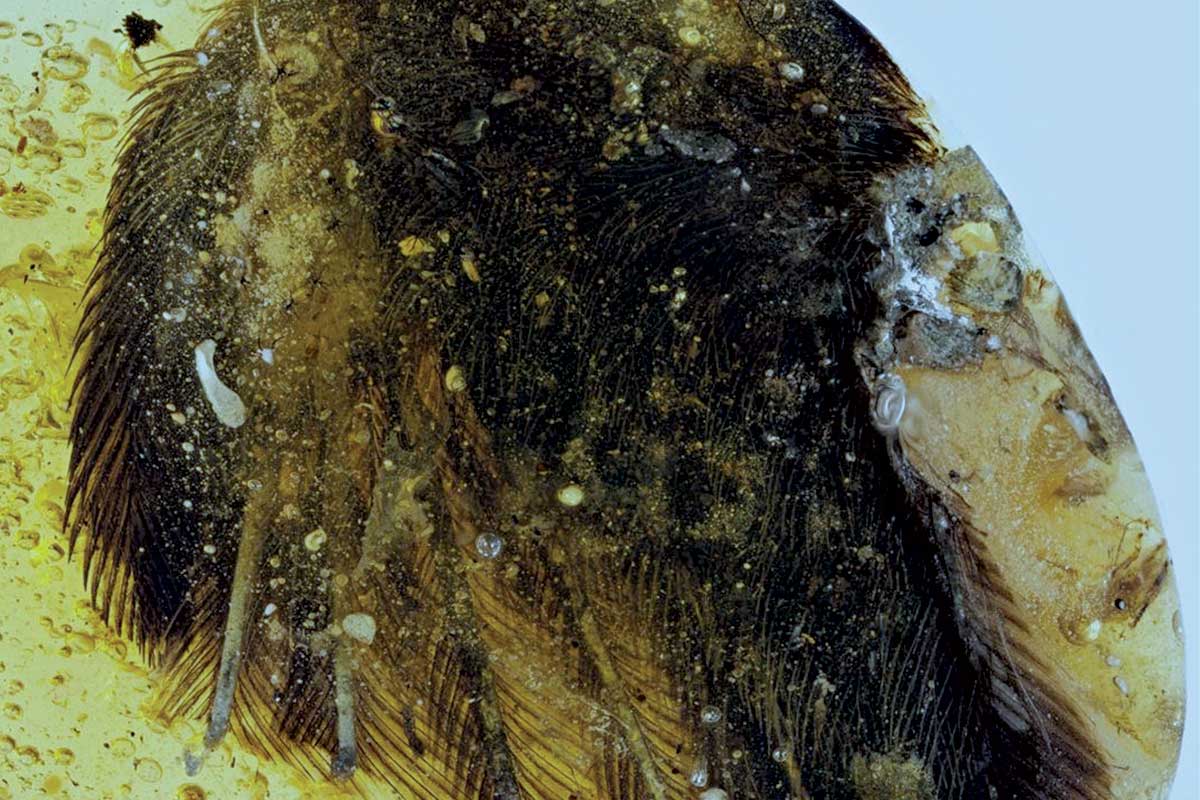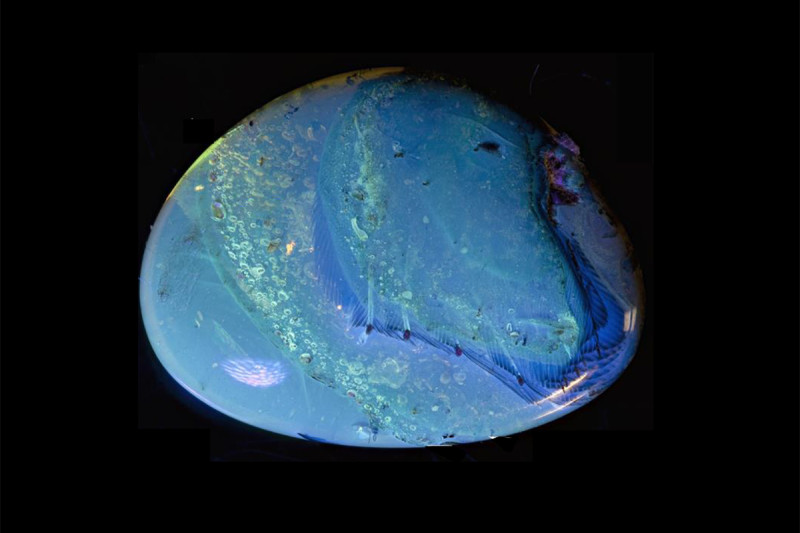In amber found perfectly preserved feathers of birdlike dinosaurs
These animals were outwardly identical to the modern birds, except for the teeth, a slightly different principle of flight and clawed fingers on the wings.

About 99 million years ago, a small bird-like dinosaur cub (one might say, a nestling) experienced a shock - its feathers stuck to the resin of a tall tree, and it was impossible to break out of the sticky trap. It was possible to free oneself only after many attempts, leaving a part of oneself in the resin - one's own feathers. The dinosaur itself was still small - probably the length of the animal did not exceed 3.5 centimeters. After some time, the resin turned to stone, turned into amber, which was found by people. The feathers in amber are excellent.
')
A piece of amber with feathers was transferred to the Chinese University of Geological Sciences in Beijing. Lida Sin, who has long been working with amber and other fossils, in which remains of ancient animals are found, has begun the study of the find.
Already managed to find out that these well-preserved feathers belong to the family "Enantsiornisovye birds" (lat. Enantiornithes ). These were not modern birds, but their ancestors. Albeit with differences, but these animals reminded them. Differences from modern birds are quite large - here the structure of the skeleton, and the presence of teeth, plus the presence on the wings of rudimentary fingers with claws at the end of the last phalanx.
The most remarkable is the peculiarity of the belt structure of the forelimbs and the bones of the wings, which indicate that the apparatus for movement in the air of these birds functioned in a different way than that of the fantail birds. Until now, there is no model that would explain the work of the aircraft of enanticornis birds. There is no functional explanation of most of the features and details of the structure of their bones of the wing and shoulder girdle.

Bird? No, dinosaur (China University of Geological Sciences from Beijing)
Finds such as these make it possible to clarify the gradual development of flight skills, to trace the evolution from dinosaurs to birds. The feathers in amber clarify the moment when animals learned to fly, and fly well, and not just plan. Despite the fact that feathers found in amber belong to grown up chicks, they are very well developed. There is no down coating characteristic of chicks of modern birds. This is another difference between the ancestors and relatives of birds from our modern birds.

As for other dinosaurs, it has now been proved that many of their species were covered with feathers, although they did not have any wings. Some dinosaur species were covered with feathers throughout their lives, others could overgrow with them at certain times. One proof of this is the remains of ancient animals that were discovered in southeastern Siberia several years ago. Imprints of bones, skin, and feather-like structures of dinosaurs of the species Kulindadromeus zabaikalicus were found in the Kulinda Valley in the Transbaikal Territory. The size of this animal reached one and a half meters, it fed on plants.
Scientists believe that feathers were common to a number of dinosaur groups. Initially, the assumptions were based on indirect signs of the presence of plumage, but in the mid-1990s, direct evidence was also found . Then the remains of small predatory dinosaurs with feather prints were found. At the moment, the presence of feathers has been established among representatives of 8 families of predatory dinosaurs, which belong to the theropod suborder. Perhaps the plumage initially served as insulation, and later helped to plan some woody species.
The most developed plumage was possessed by some species of the Dromeosaur family, who were arboreal and used long outline feathers for planning from tree to tree. Such species had almost modern feather cover, with down, covering and contour feathers.

About 99 million years ago, a small bird-like dinosaur cub (one might say, a nestling) experienced a shock - its feathers stuck to the resin of a tall tree, and it was impossible to break out of the sticky trap. It was possible to free oneself only after many attempts, leaving a part of oneself in the resin - one's own feathers. The dinosaur itself was still small - probably the length of the animal did not exceed 3.5 centimeters. After some time, the resin turned to stone, turned into amber, which was found by people. The feathers in amber are excellent.
')
A piece of amber with feathers was transferred to the Chinese University of Geological Sciences in Beijing. Lida Sin, who has long been working with amber and other fossils, in which remains of ancient animals are found, has begun the study of the find.
Already managed to find out that these well-preserved feathers belong to the family "Enantsiornisovye birds" (lat. Enantiornithes ). These were not modern birds, but their ancestors. Albeit with differences, but these animals reminded them. Differences from modern birds are quite large - here the structure of the skeleton, and the presence of teeth, plus the presence on the wings of rudimentary fingers with claws at the end of the last phalanx.
The most remarkable is the peculiarity of the belt structure of the forelimbs and the bones of the wings, which indicate that the apparatus for movement in the air of these birds functioned in a different way than that of the fantail birds. Until now, there is no model that would explain the work of the aircraft of enanticornis birds. There is no functional explanation of most of the features and details of the structure of their bones of the wing and shoulder girdle.

Bird? No, dinosaur (China University of Geological Sciences from Beijing)
Finds such as these make it possible to clarify the gradual development of flight skills, to trace the evolution from dinosaurs to birds. The feathers in amber clarify the moment when animals learned to fly, and fly well, and not just plan. Despite the fact that feathers found in amber belong to grown up chicks, they are very well developed. There is no down coating characteristic of chicks of modern birds. This is another difference between the ancestors and relatives of birds from our modern birds.

As for other dinosaurs, it has now been proved that many of their species were covered with feathers, although they did not have any wings. Some dinosaur species were covered with feathers throughout their lives, others could overgrow with them at certain times. One proof of this is the remains of ancient animals that were discovered in southeastern Siberia several years ago. Imprints of bones, skin, and feather-like structures of dinosaurs of the species Kulindadromeus zabaikalicus were found in the Kulinda Valley in the Transbaikal Territory. The size of this animal reached one and a half meters, it fed on plants.
Scientists believe that feathers were common to a number of dinosaur groups. Initially, the assumptions were based on indirect signs of the presence of plumage, but in the mid-1990s, direct evidence was also found . Then the remains of small predatory dinosaurs with feather prints were found. At the moment, the presence of feathers has been established among representatives of 8 families of predatory dinosaurs, which belong to the theropod suborder. Perhaps the plumage initially served as insulation, and later helped to plan some woody species.
The most developed plumage was possessed by some species of the Dromeosaur family, who were arboreal and used long outline feathers for planning from tree to tree. Such species had almost modern feather cover, with down, covering and contour feathers.
Source: https://habr.com/ru/post/395747/
All Articles